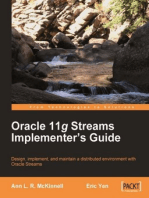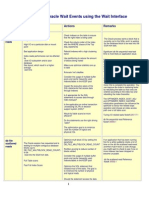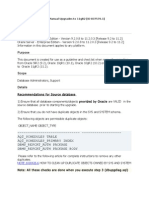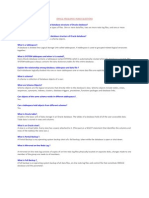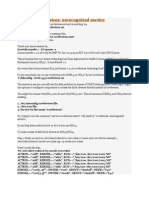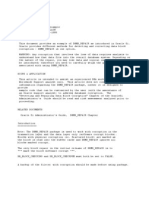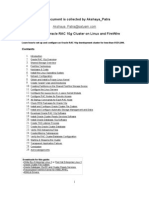RMAN Question & Answers: What Is RMAN and How To Configure It?
RMAN Question & Answers: What Is RMAN and How To Configure It?
Uploaded by
Nst TnagarCopyright:
Available Formats
RMAN Question & Answers: What Is RMAN and How To Configure It?
RMAN Question & Answers: What Is RMAN and How To Configure It?
Uploaded by
Nst TnagarOriginal Title
Copyright
Available Formats
Share this document
Did you find this document useful?
Is this content inappropriate?
Copyright:
Available Formats
RMAN Question & Answers: What Is RMAN and How To Configure It?
RMAN Question & Answers: What Is RMAN and How To Configure It?
Uploaded by
Nst TnagarCopyright:
Available Formats
RMAN Question & Answers
What is RMAN and How to configure it?
RMAN is an Oracle Database client It performs backup and recovery tasks on your databases and automates administration of your backup strategies It greatly simplifies the dba jobs by managing the production database's backing up, restoring, and recovering database files This tool integrates with sessions running on an Oracle database to perform a range of backup and recovery activities, including maintaining an RMAN repository of historical data about backups There is no additional installation required for this tool It is by default get installed with the oracle database installation The RMAN environment consists of the utilities and databases that play a role in acking up your data We can access RMAN through the command line or through Oracle Enterprise Manager
2) Why to use RMAN? RMAN gives you access to several backup and recovery techniques and features not available with user-managed backup and recovery. The most noteworthy are the following:
Automatic specification of files to include in a backup Establishes the name and locations of all files to be backed up
Maintain backup repository
Backups are recorded in the control file, which is the main repository of RMAN metadata Additionally, you can store this metadata in a recovery catalog
Incremental backups Incremental backup stores only blocks changed since a previous backup Thus, they provide more compact backups and faster recovery, thereby reducing the need to apply redo during datafile media recovery Unused block compression: In unused block compression, RMAN can skip data blocks that have never been used
Block media recovery
We can repair a datafile with only a small number of corrupt data blocks without taking it offline or restoring it from backup
Binary compression A binary compression mechanism integrated into Oracle Database reduces the size of backups
Encrypted backups RMAN uses backup encryption capabilities integrated into Oracle Database to store backup sets in an encrypted format
Corrupt block detection RMAN checks for the block corruption before taking its backup
3) How RMAN works?
RMAN backup and recovery operation for a target database are managed by RMAN client RMAN uses the target database control file to gather metadata about the target database and to store information about its own operations The RMAN client itself does not perform backup, restore, or recovery operations When you connect the RMAN client to a target database, RMAN allocates server sessions on the target instance and directs them to perform the operations The work of backup and recovery is performed by server sessions running on the target database A channel establishes a connection from the RMAN client to a target or auxiliary database instance by starting a server session on the instance The channel reads data into memory, processes it, and writes it to the output device When you take a database backup using RMAN, you need to connect to the target database using RMAN Client The RMAN client can use Oracle Net to connect to a target database, so it can be located on any host that is connected to the target host through Oracle Net For backup you need to allocate explicit or implicit channel to the target database An RMAN channel represents one stream of data to a device, and corresponds to one database server session. This session dynamically collect information of the files from the target database control file before taking the backup or while restoring For example if you give ' Backup database ' from RMAN, it will first get all the datafiles information from the controlfile
Then it will divide all the datafiles among the allocated channels. (Roughly equal size of work as per the datafile size) Then it takes the backup in 2 steps
Step1: The channel will read all the Blocks of the entire datafile to find out all the formatted blocks to backup
Note: RMAN do not take backup of the unformatted blocks
Step2: In the second step it takes back up of the formatted blocks
Example:
This is the best advantage of using RMAN as it only takes back up of the required blocks Lets say in a datafile of 100 MB size, there may be only 10 MB of use full data and rest 90 MB is free then RMAN will only take backup of those 10 MB
4) What O/S and oracle user privilege required using RMAN?
RMAN always connects to the target or auxiliary database using the SYSDBA privilege RMAN always connects to the target or auxiliary database using the SYSDBA privilege Its connections to a database are specified and authenticated in the same way as SQL*Plus connections to a database The O/S user should be part of the DBA group For remote connection it needs the password file Authentication Target database should have the initialization parameter REMOTE_LOGIN_PASSWORDFILE set to EXCLUSIVE or SHARED
5) RMAN terminology:
A target database:
An Oracle database to which RMAN is connected with the TARGET keyword A target database is a database on which RMAN is performing backup and recovery operations
RMAN always maintains metadata about its operations on a database in the control file of the database
A recovery Catalog:
A separate database schema used to record RMAN activity against one or more target databases A recovery catalog preserves RMAN repository metadata if the control file is lost, making it much easier to restore and recover following the loss of the control file The database may overwrite older records in the control file, but RMAN maintains records forever in the catalog unless deleted by the user
Backup sets: RMAN can store backup data in a logical structure called a backup set, which is the smallest unit of an RMAN backup One backup set contains one or more datafiles a section of datafile or archivelogs Backup Piece: A backup set contains one or more binary files in an RMAN-specific format This file is known as a backup piece Each backup piece is a single output file The size of a backup piece can be restricted; if the size is not restricted, the backup set will comprise one backup piece Backup piece size should be restricted to no larger than the maximum file size that your filesystem will support Image copies:
An image copy is a copy of a single file (datafile, archivelog, or controlfile) It is very similar to an O/S copy of the file It is not a backupset or a backup piece No compression is performed
Snapshot Controlfile: When RMAN needs to resynchronize from a read-consistent version of the control file, it creates a temporary snapshot control file The default name for the snapshot control file is port-specific Database Incarnation:
Whenever you perform incomplete recovery or perform recovery using a backup control file, you must reset the online redo logs when you open the database The new version of the reset database is called a new incarnation The reset database command directs RMAN to create a new database incarnation record in the recovery catalog
This new incarnation record indicates the current incarnation
6) What is RMAN Configuration and how to configure it?
The RMAN backup and recovery environment is preconfigured for each target database The configuration is persistent and applies to all subsequent operations on this target database, even if you exit and restart RMAN RMAN configured settings can specify backup devices, configure a connection to a backup device , policies affecting backup strategy, encryption algorithm, snap shot controlfile loaion and others By default there are few default configuration are set when you login to RMAN You can customize them as per your requirement Any time you can check the current setting by using the "Show all command CONFIGURE command is used to create persistent settings in the RMAN environment, which apply to all subsequent operations, even if you exit and restart RMAN
7) How to check RMAN configuration? RMAN>Show all;
8) How to reset to default configuration? To reset the default configuration setting use Connect to the target database from sqlplus and run SQL> connect <sys/passwd as sysdba>@target_database; SQL> execute dbms_backup_restore.resetConfig;
RMAN Catalog Database
9) What is Catalog database and How to configure it? This is a separate database which contains catalog schema You can use the same target database as the catalog database but its not at all recommended
10) How Many catalog database I can have?
You can have multiple catalog databases for the same target database But at a time you can connect to only 1 catalog database via RMAN. Its not recommended to have multiple catalog database
11) Is this mandatory to use catalog database? No! Its an optional one
12) What is the advantage of catalog database?
Catalog database is a secondary storage of backup metadata Its very useful in case you lost the current controlfile, as all the backup information are there in the catalog schema Secondly from contolfile the older backup information are aged out depending upon the control_file_record_keep_time RMAN catalog database mainten the history of data
13) What is the difference between catalog database & catalog schema? Catalog database is like any other database which contains the RMAN catalog user's schema 14) What happen if catalog database lost?
Since catalog database is an option one there is no direct effect of loss of catalog database Create a new catalog database and register the target database with the newly createdcatalog one All the backup information from the target database current controlfile will be updated to the catalog schema If any backup information which is aged out from the target database then you need to manually catalog those backup pieces
RMAN backup:
15) What is the database file's that RMAN can backup? RMAN can backup Controlfile, Datafiles, Archive logs, standby database controfile, Spfile
16) What is the database file's that RMAN can not backup? RMAN can not take backup of the pfile, Redo logs, network configuration files, password files, external tables and the contents of the Oracle home files
17) Can I have archivelogs and datafile backup in a single backupset? No. We can not put datafiles and archive logs in the same backupset 18) Can I have datafiles and contolfile backup in a single backup set?
Yes If the controlfile autobackup is not ON then RMAN takes backup of controlfile along with the datafile 1, whenever you take backup of the database or System tablespace
19) Can I regulate the size of backup piece and backup set?
Yes! You can set max size of the backupset as well as the backup piece By default one RMAN channel creates a single backupset with one backup piece in it You can use the MAXPIECESIZE channel parameter to set limits on the size of backup pieces You can also use the MAXSETSIZE parameter on the BACKUP and CONFIGURE commands to set a limit for the size of backup sets
20) What is the difference between backup set backup and Image copy backup?
A backup set is an RMAN-specific proprietary format, whereas an image copy is a bit-for-bit copy of a file By default, RMAN creates backup sets
21) What is RMAN consistent backup and inconsistent backup?
A consistent backup occurs when the database is in a consistent state That means backup of the database taken after a shutdown immediate, shutdown normal or shutdown transactional If the database is shutdown with abort option then its not a consistent backup A backup when when the database is up and running is called an inconsistent backup
When a database is restored from an inconsistent backup, Oracle must perform media recovery before the database can be opened, applying any pending changes from the redo logs You can not take inconsistent backup when the database is in NoArchivelog mode
22) Can I take RMAN backup when the database is down? No! You can take RMAN backup only when the target database is Open or in Mount stage Its because RMAN keep the backup metadata in controfile Only in open or mount mode controlfile is accessible
23) Do I need to place the database in begin backup mode while taking RMAN inconsistent backup? RMAN does not require extra logging or backup mode because it knows the format of data blocks RMAN is guaranteed not to back up fractured blocks No extra redo is generated during RMAN backup
24) Can I compress RMAN backups? RMAN supports binary compression of backup sets The supported algorithms are BZIP2 (default) and ZLIB Its not recommended to compress the RMAN backup using any other OS or third party utility
Note: RMAN compressed backup with BZIP2 provides great compression but is CPU intensive
Using ZLIB compression requires the Oracle Database 11g Advanced Compression Option and is only supported with an 11g database The feature is not backward compatible with 10g databases
25) Can I encrypt RMAN backup? RMAN supports backup encryption for backup sets You can use wallet-based transparent encryption, password-based encryption, or both You can use the CONFIGURE ENCRYPTION command to configure persistent transparent encryption Use the SET ENCRYPTION, command at the RMAN session level to specify passwordbased encryption
26) Can RMAN take backup to Tape?
Yes! We can use RMAN for the tape backup But RMAN can not able to write directly to tape You need to have third party Media Management Software installed Oracle has published an API specification which Media Management Vendor's who are members of Oracle's Backup Solutions Partner program have access to Media Management Vendors (MMVs) then write an interface library which the Oracle server uses to write and read to and from tape Starting from oracle 10g R2 oracle has its Own Media management software for the database backup to tape called OSB
27) How RMAN Interact with Media manager?
Before performing backup or restore to a media manager, you must allocate one or more channels or configure default channels for use with the media manager to handle the communication with the media manager RMAN does not issue specific commands to load, label, or unload tapes When backing up, RMAN gives the media manager a stream of bytes and associates a unique name with this stream When RMAN needs to restore the backup, it asks the media manager to retrieve the byte stream All details of how and where that stream is stored are handled entirely by the media manager
28) What is Proxy copy backup to tape?
Proxy copy is functionality, supported by few media manager in which they handle the entire data movement between datafiles and the backup devices Such products may use technologies such as high-speed connections between storage and media subsystems to reduce load on the primary database server RMAN provides a list of files requiring backup or restore to the media manager, which in turn makes all decisions regarding how and when to move the data
29) What is Oracle Secure backup?
Oracle Secure Backup is a media manager provided by oracle that provides reliable and secure data protection through file system backup to tape All major tape drives and tape libraries in SAN, Gigabit Ethernet, and SCSI environments are supported
30) Can I restore or duplicate my previous version database using a later version of Oracle? For example, is it possible to restore a 9i backup while using the 10g executables?
It is possible to use the 10.2 RMAN executable to restore a 9.2 database (same for 11.2 to 11.1 or 11.1 to 10.2, etc) even if the restored datafiles will be stored in ASM RMAN is configured so that a higher release is able to restore a lower release, but it is strongly suggested you use only the same version
31) Can I restore or duplicate between two different patchset levels?
As you can restore between different Oracle versions, you can also do so between two different patchset levels Alter database open resetlogs upgrade; OR alter database open resetlogs downgrade;
32) Can I restore or duplicate between two different versions of the same operating system?
For example, can I restore my 9.2.0.1.0 RMAN backup taken against a host running Solaris 9 to a different machine where 9.2.0.1.0 is installed but where that host is running Solaris 10? If the same Oracle Server installation CDs (media pack) can be used to install 9.2.0.1.0 on Solaris 9 and Solaris 10, this type of restore is supportable
33) Is it possible to restore or duplicate when the bit level (32 bit or 64 bit) of Oracle does not match?
For example, is it possible to restore or duplicate my 9.2. 64-bit database to a 9.2.32bit installation? It is preferable to keep the same bit version when performing a restore/recovery However, excluding the use of duplicate command, the use of the same operating system platform should allow for a restore/recovery between bit levels (32 bit or 64 bit) of Oracle Note, this may be specific to the particular operating system and any problems with this should be reported to Oracle Support If you will be running the 64-bit database against the 32-bit binary files or vice versa, after the recovery has ended the database bit version must be converted using utlirp.sql If you do not run utlirp.sql you will see errors including but not limited to: ORA-06553: PLS-801: INTERNAL ERROR [56319]
34) Can I restore or duplicate my RMAN backup between two different platforms such as Solaris to Linux?
In general, you cannot restore or duplicate between two different platforms
35) What are the corruption types?
Datafile Block Corruption - Physical/Logical Table/Index Inconsistency Extents Inconsistencies Data Dictionary Inconsistencies
Scenarios:
Goal: How to identify all the corrupted segments in the database reported by RMAN? Solution: Step 1: Identify the corrupt blocks (Datafile Block Corruption - Intra block corruption)
RMAN> backup validate check logical database;
To make it faster, it can be configured to use PARALLELISM with multiple channels:
RMAN> run { allocate channel d1 type disk; allocate channel d2 type disk; allocate channel d3 type disk; allocate channel d4 type disk; backup validate check logical database; }
Step2: Using the view v$database_block_corruption: SQL> select * from v$database_block_corruption; FILE# BLOCK# BLOCKS CORRUPTION_CHANGE# CORRUPTIO ------------------------------------------------------------------------------------------------------------
6 10 8183236781662 6 42 0 6 0 6 6 0 5 rows selected. 50 26 34
1 LOGICAL 1 FRACTURED 2 CHECKSUM 1 8183236781952 4 FRACTURED
LOGICAL
Datafile Block Corruption - Intra block corruption
It refers to intra block corruptions that may cause different errors like ORA-1578, ORA-8103, ORA-1410, ORA-600 etc. Oracle classifies the corruptions as Physical and Logical
To identify both Physical and Logical Block Corruptions use the "CHECK LOGICAL" option It checks the complete database for both corruptions without actually doing a backup
Solution1:
$ rman target / RMAN> backup check logical validate database;
$ rman target / RMAN> backup check logical database;
Solution2:
Chek the view V$DATABASE_BLOCK_CORRUPTION to identify the block corruptions detected by RMAN
Solution3: DBVerify - Identify Datafile Block Corruptions
DBVERIFY identify Physical and Logical Intra Block Corruptions by default Dbverify cannot be run for the whole database in a single command It does not need a database connection either
dbv file=<datafile name> blocksize=<datafile Block size>
RMAN Vs DBVerify - Datafile Intra Block Corruption
When the logical option is used by RMAN, it does exactly the same checks as DBV does for intra block corruption. RMAN can be run with PARALLELISM using multiple channels making it faster than DBV which can not be run in parallel in a single command DBV checks for empty blocks. In 10g RMAN may not check blocks in free extents when Locally Managed Tablespaces are used. In 11g RMAN checks for both free and used extents.
Both DBV and RMAN (11g) can check for a range of blocks. RMAN: VALIDATE DATAFILE 1 BLOCK 10 to 100;. DBV: start=10 end=100 RMAN keeps corruption information in the control file (v$database_block_corruption, v$backup_corruption). DBV does not. RMAN may not report the corruption details like what is exactly corrupted in a block reported as a LOGICAL corrupted block. DBV reports the corruption details in the screen or in a log file. DBV can scan blocks with a higher SCN than a given SCN. DBV does not need a connection to the database.
dentify TABLE / INDEX Inconsistency
Table / Index inconsistencies is when an entry in the Table does not exist in the Index or vice versa. The common errors are ORA-8102, ORA-600 [kdsgrp1], ORA1499 by "analyze validate structure cascade".
The tool to identify TABLE / INDEX inconsistencies is the ANALYZE command: analyze table <table name> validate structure cascade;
When an inconsistency is identified, the above analyze command will produce error ORA-1499 and a trace file.
35) What Happens When A Tablespace/Database Is Kept In Begin Backup Mode?
One danger in making online backups is the possibility of inconsistent data within a block For example, assume that you are backing up block 100 in datafile users.dbf Also, assume that the copy utility reads the entire block while DBWR is in the middle of updating the block In this case, the copy utility may read the old data in the top half of the block and the new data in the bottom top half of the block The result is called a fractured block, meaning that the data contained in this block is not consistent at a given SCN
Therefore oracle internally manages the consistency as below : The first time a block is changed in a datafile that is in hot backup mode, the entire block is written to the redo log files, not just the changed bytes Normally only the changed bytes (a redo vector) is written In hot backup mode, the entire block is logged the first time This is because you can get into a situation where the process copying the datafile and DBWR are working on the same block simultaneously Lets say they are and the OS blocking read factor is 512bytes (the OS reads 512 bytes from disk at a time). The backup program goes to read an 8k Oracle block. The OS gives it 4k. Meanwhile -- DBWR has asked to rewrite this block. the OS schedules the DBWR write to occur right now. The entire 8k block is rewritten. The backup program starts running again (multi-tasking OS here) and reads the last 4k of the block. The backup program has now gotten an fractured block -- the head and tail are from two points in time. We cannot deal with that during recovery. Hence, we log the entire block image so that during recovery, this block is totally rewritten from redo and is consistent with itself atleast. We can recover it from there. 2. The datafile headers which contain the SCN of the last completed checkpoint are not updated while a file is in hot backup mode. This lets the recovery process understand what archive redo log files might be needed to fully recover this file.
To limit the effect of this additional logging, you should ensure you only place one tablepspace at a time in backup mode and bring the tablespace out of backup mode as soon as you have backed it up. This will reduce the number of blocks that may have to be logged to the minimum possible. Try to take the hot/online backups when there is less / no load on the database, so that less redo will be generated. You might like:
You might also like
- Sistema Electrico Ford-Freestyle - 2006 - EN - Manual - de - Taller - Diagrama - Electrico - 132d5e7f2aDocument143 pagesSistema Electrico Ford-Freestyle - 2006 - EN - Manual - de - Taller - Diagrama - Electrico - 132d5e7f2aCarlos Ortega Martinez100% (1)
- Broken 8th Feel PDFDocument6 pagesBroken 8th Feel PDFarjun100% (2)
- Oracle 19CDocument17 pagesOracle 19CNagajyothi Kodali100% (1)
- Oracle Database Administration Interview Questions You'll Most Likely Be Asked: Job Interview Questions SeriesFrom EverandOracle Database Administration Interview Questions You'll Most Likely Be Asked: Job Interview Questions SeriesRating: 5 out of 5 stars5/5 (1)
- Starting Database Administration: Oracle DBAFrom EverandStarting Database Administration: Oracle DBARating: 3 out of 5 stars3/5 (2)
- Step by Step Golden GateDocument27 pagesStep by Step Golden GatebillNo ratings yet
- Presentation Guaranteed Restore PointsDocument25 pagesPresentation Guaranteed Restore PointsViaggio ItaliaNo ratings yet
- ACTIVE DATABASE DUPLICATION IN SAME SERVER (11g) PDFDocument14 pagesACTIVE DATABASE DUPLICATION IN SAME SERVER (11g) PDFG.R.THIYAGU ; Oracle DBA100% (2)
- RAC-ASM-VOTING DISK Interview Questions & AnswerDocument18 pagesRAC-ASM-VOTING DISK Interview Questions & AnswerNuhu Magwai100% (1)
- DBA Daily - Weekly - Monthly or Quarterly ChecklistDocument3 pagesDBA Daily - Weekly - Monthly or Quarterly Checklistbhanuchander26No ratings yet
- RMAN - Frequently Asked Question (FAQ) (ID 469777.1)Document10 pagesRMAN - Frequently Asked Question (FAQ) (ID 469777.1)SahilTyagiNo ratings yet
- Oracle Database 11g - Underground Advice for Database Administrators: Beyond the basicsFrom EverandOracle Database 11g - Underground Advice for Database Administrators: Beyond the basicsNo ratings yet
- UpgradeDocument27 pagesUpgradeAugustine OderoNo ratings yet
- 02 - DB Architecture OverviewDocument58 pages02 - DB Architecture Overviewpiciul2010100% (1)
- Performance Tuning Oracle Rac On LinuxDocument12 pagesPerformance Tuning Oracle Rac On LinuxvigyanikNo ratings yet
- ORACLE Interview Questions and AnswersDocument134 pagesORACLE Interview Questions and Answersvikas595100% (1)
- Oracle Tuning Part 3Document84 pagesOracle Tuning Part 3Angel DuenasNo ratings yet
- DBA Task FinishedDocument37 pagesDBA Task FinishedViswanath Janakiraman100% (2)
- Oracle SQL Tuning - File IO PerformanceDocument6 pagesOracle SQL Tuning - File IO Performancelado55No ratings yet
- Automating Oracle Database Startup and Shutdown On Linux SOPDocument3 pagesAutomating Oracle Database Startup and Shutdown On Linux SOPFrancesHsieh100% (1)
- Oracle Wait Event - Common Issues and SolutionsDocument7 pagesOracle Wait Event - Common Issues and Solutionstssr2001No ratings yet
- Reorg of Table OracleDocument12 pagesReorg of Table OraclepratyushNo ratings yet
- Oracle RMAN Interview QuestionsDocument3 pagesOracle RMAN Interview QuestionsdbareddyNo ratings yet
- Oracle Rman Duplicate Database FeatureDocument3 pagesOracle Rman Duplicate Database Featuremartin_seaNo ratings yet
- Demo - 2 Tablespace ManagementDocument17 pagesDemo - 2 Tablespace ManagementVeesams SrinivasNo ratings yet
- Can One Restore RMAN Backups Without A CONTROLFILE and Recovery Catalog?Document7 pagesCan One Restore RMAN Backups Without A CONTROLFILE and Recovery Catalog?a.aloysiusNo ratings yet
- Complete Checklist For Manual Upgrades To 11gR2Document15 pagesComplete Checklist For Manual Upgrades To 11gR2K Kunal RajNo ratings yet
- QuestionaireDocument106 pagesQuestionairevenkatsainath06No ratings yet
- DB12c Tuning New Features Alex Zaballa PDFDocument82 pagesDB12c Tuning New Features Alex Zaballa PDFGanesh KaralkarNo ratings yet
- Scripts DBADocument7 pagesScripts DBAmdinesh81No ratings yet
- Creating Single Instance Physical Standby For A RAC Primary - 12cDocument14 pagesCreating Single Instance Physical Standby For A RAC Primary - 12cKiranNo ratings yet
- 19c Upgrade Oracle Database Manually From 12C To 19CDocument26 pages19c Upgrade Oracle Database Manually From 12C To 19Cjanmarkowski23No ratings yet
- Install StatspackDocument12 pagesInstall Statspackapi-27472162No ratings yet
- Oracle Tablespace GuideDocument29 pagesOracle Tablespace GuideJSNo ratings yet
- Top For Oracle 143Document10 pagesTop For Oracle 143sureshdba2009No ratings yet
- Data Guard Failover Test Using SQLDocument8 pagesData Guard Failover Test Using SQLKrishna8765100% (1)
- Troubleshooting CMDocument6 pagesTroubleshooting CMRatnodeep RoyNo ratings yet
- General Backup and Recovery Questions: Why and When Should I Backup My Database?Document16 pagesGeneral Backup and Recovery Questions: Why and When Should I Backup My Database?tejaburle003100% (1)
- Oracle Dba ScriptsDocument153 pagesOracle Dba Scriptsraniboi100% (1)
- Loss of Undo Tablespace Datafile and Process To Restore and RecoverDocument9 pagesLoss of Undo Tablespace Datafile and Process To Restore and Recoverapi-293702630No ratings yet
- RMAN ACTIVE DATABASE DUPLICATION SERVER TO SERVER - DIRECTORY STRUCTURE IS DIFFERENT (11g) PDFDocument17 pagesRMAN ACTIVE DATABASE DUPLICATION SERVER TO SERVER - DIRECTORY STRUCTURE IS DIFFERENT (11g) PDFG.R.THIYAGU ; Oracle DBA100% (4)
- Oracle DBA Fundamental 1 Exam Questions and Answers: Buffer Cache Redo Log in TheDocument17 pagesOracle DBA Fundamental 1 Exam Questions and Answers: Buffer Cache Redo Log in Theutagore58100% (1)
- Performance Tunning StepsDocument11 pagesPerformance Tunning StepsVinu3012No ratings yet
- Oracle ArchitecturalComponentsDocument35 pagesOracle ArchitecturalComponentsali0196650% (2)
- DBA CommandsDocument20 pagesDBA CommandsVinu3012No ratings yet
- TablespaceDocument3 pagesTablespacecgiriraj100% (1)
- Oracle Backup and RecoveryDocument55 pagesOracle Backup and RecoverySantanu Das100% (1)
- Tuning The Redolog Buffer Cache and Resolving Redo Latch ContentionDocument5 pagesTuning The Redolog Buffer Cache and Resolving Redo Latch ContentionMelissa MillerNo ratings yet
- How To Stabilize The Execution Plan Using SQL PLAN BaselineDocument3 pagesHow To Stabilize The Execution Plan Using SQL PLAN BaselinenizamNo ratings yet
- CloningDocument3 pagesCloningsrutidbaNo ratings yet
- Oracle Database 12c Backup and Recovery Workshop Ed 2Document6 pagesOracle Database 12c Backup and Recovery Workshop Ed 2Manuel Elizalde100% (1)
- How To Sync Standby DatabaseDocument7 pagesHow To Sync Standby Databaseshaik.naimeNo ratings yet
- DB Tuning ScriptsDocument4 pagesDB Tuning Scriptssundarsms2001100% (1)
- Schema Refresh Steps On Same Database PDFDocument8 pagesSchema Refresh Steps On Same Database PDFG.R.THIYAGU ; Oracle DBA100% (4)
- How To Install and Configure Oracle Golden GateDocument12 pagesHow To Install and Configure Oracle Golden GatesadineniNo ratings yet
- RMAN Daily Weekly BackupDocument4 pagesRMAN Daily Weekly BackupfarooqahmedsiddiquiNo ratings yet
- Oracle Backup and Recovery Interview Questions and AnswersDocument2 pagesOracle Backup and Recovery Interview Questions and AnswersMahadev Naiknavre100% (1)
- Oracle DBA ChecklistDocument3 pagesOracle DBA ChecklistmvineetaNo ratings yet
- DG - Applying Psu Patch in Dataguard EnvironmentDocument23 pagesDG - Applying Psu Patch in Dataguard EnvironmentG.R.THIYAGU ; Oracle DBA100% (3)
- Asm InterviewDocument6 pagesAsm InterviewNst TnagarNo ratings yet
- Oracle RAC Performance TuningDocument44 pagesOracle RAC Performance TuningNst TnagarNo ratings yet
- Tunning Tip and Tricks BasicDocument44 pagesTunning Tip and Tricks BasicNst TnagarNo ratings yet
- Oracle FAQsDocument99 pagesOracle FAQsNst TnagarNo ratings yet
- Gather Statistics With DBMS - STATS: by Jeff Hunter, Sr. Database AdministratorDocument26 pagesGather Statistics With DBMS - STATS: by Jeff Hunter, Sr. Database AdministratorNst TnagarNo ratings yet
- HTTP://WWW - Sioug.si/predavanja/97/platinum/sld012.htm : 1.what Is An Oracle Instance?Document6 pagesHTTP://WWW - Sioug.si/predavanja/97/platinum/sld012.htm : 1.what Is An Oracle Instance?Vijay Tilak Vangaveti100% (1)
- 10G To 11GDocument161 pages10G To 11GNst TnagarNo ratings yet
- Raw DevicesDocument3 pagesRaw DevicesNst TnagarNo ratings yet
- Dbms RepairDocument46 pagesDbms RepairNst TnagarNo ratings yet
- Automatic Shared Memory Management in Oracle 10g: ZahidDocument10 pagesAutomatic Shared Memory Management in Oracle 10g: ZahidNst TnagarNo ratings yet
- Rac TroubleDocument20 pagesRac TroubleNst TnagarNo ratings yet
- This Document Is Collected by Akshaya - PatraDocument68 pagesThis Document Is Collected by Akshaya - PatraNst TnagarNo ratings yet
- CareersDocument1 pageCareersNst TnagarNo ratings yet
- Orace Rac TafDocument4 pagesOrace Rac TafNst TnagarNo ratings yet
- Walk in 02012012Document1 pageWalk in 02012012Nst TnagarNo ratings yet
- SUHAILBASHAdbaDocument3 pagesSUHAILBASHAdbaNst TnagarNo ratings yet
- 10 GracDocument3 pages10 GracNst TnagarNo ratings yet
- 18 Partitioned Tables and Indexes: Introduction To PartitioningDocument84 pages18 Partitioned Tables and Indexes: Introduction To PartitioningNst TnagarNo ratings yet
- Educational Details: ObjectiveDocument3 pagesEducational Details: ObjectiveNst TnagarNo ratings yet
- Testing Automated - Course Content: 1. Introduction To Automation TestingDocument7 pagesTesting Automated - Course Content: 1. Introduction To Automation TestingNst TnagarNo ratings yet
- Sophia CVDocument3 pagesSophia CVNst TnagarNo ratings yet
- Project Report On Summer TrainingDocument60 pagesProject Report On Summer Trainingmittu720No ratings yet
- KR 6 R700 Sixx: Workspace GraphicDocument1 pageKR 6 R700 Sixx: Workspace GraphicIhateyouNo ratings yet
- Chapter 3 Discrete Random Variable PDFDocument23 pagesChapter 3 Discrete Random Variable PDFLizhe KhorNo ratings yet
- Dlink DNS 320Document4 pagesDlink DNS 320yassineNo ratings yet
- GMAT-800 Performance Chart 15novDocument13 pagesGMAT-800 Performance Chart 15novArun PrakashNo ratings yet
- Sample Copy of The Omr Is Attached Students Can SeeDocument2 pagesSample Copy of The Omr Is Attached Students Can SeePrachi ManikpuriNo ratings yet
- PRF - SupplierDocument18 pagesPRF - Supplierdeanwolves16No ratings yet
- Hydrocor 226, Hydrocor 226 Special, Hydrocor 226 LABSA, Hydrocor 226 LS - EN - 2.0Document9 pagesHydrocor 226, Hydrocor 226 Special, Hydrocor 226 LABSA, Hydrocor 226 LS - EN - 2.0Shilca BarriosNo ratings yet
- MGN XXX (M+F) : Lifeboat: Fitting of 'Fall Preventer Devices' To Reduce The Danger of Accidental On-Load Hook ReleaseDocument7 pagesMGN XXX (M+F) : Lifeboat: Fitting of 'Fall Preventer Devices' To Reduce The Danger of Accidental On-Load Hook ReleaseejassssNo ratings yet
- PLDT V CIR (Digest)Document2 pagesPLDT V CIR (Digest)adee100% (1)
- Atlas FiltriDocument18 pagesAtlas FiltriCristi CicireanNo ratings yet
- AYUSHYA SUKTAM - Gleanings From Sanskrit LiteratureDocument5 pagesAYUSHYA SUKTAM - Gleanings From Sanskrit LiteratureRajesh RamakrishnanNo ratings yet
- Customs ClearanceDocument35 pagesCustoms ClearanceZhizheng ChenNo ratings yet
- Fundamentals of CSS - Learn CSS - The Box Model Cheatsheet - Codecademy PDFDocument3 pagesFundamentals of CSS - Learn CSS - The Box Model Cheatsheet - Codecademy PDFJuan Esteban Rivera CoboNo ratings yet
- Lecture - Software Testing and ApplicationsDocument30 pagesLecture - Software Testing and ApplicationsKaran PatelNo ratings yet
- Count One (Conspiracy To Commit Securities Fraud) : IndictmentDocument22 pagesCount One (Conspiracy To Commit Securities Fraud) : IndictmentgfhghgvhgNo ratings yet
- Katalog Krushers 1.1Document8 pagesKatalog Krushers 1.1egasykesNo ratings yet
- Man Chester United Soccer Club - Vivekanandan ThangamaniDocument6 pagesMan Chester United Soccer Club - Vivekanandan ThangamaniVivek Bayday100% (1)
- Houghton Dromus B TdsDocument1 pageHoughton Dromus B TdsRoberto Alfaro EspinozaNo ratings yet
- Owners Manual w11555817 RevbDocument48 pagesOwners Manual w11555817 RevbunendedNo ratings yet
- WFC ColoringDocument7 pagesWFC ColoringworrywarriorNo ratings yet
- QCDD Fire Safety Standards Civil Defense CommentsDocument7 pagesQCDD Fire Safety Standards Civil Defense CommentsjaimonjoyNo ratings yet
- Camalco Bauxite Product Technical SpecificationDocument1 pageCamalco Bauxite Product Technical SpecificationnovaNo ratings yet
- MSC Chennamsetty LH 2020Document56 pagesMSC Chennamsetty LH 2020runrajarun1819No ratings yet
- DMTDocument1 pageDMTPipo Canelas100% (3)
- Flanged Drain ValvesDocument2 pagesFlanged Drain ValvescasalasNo ratings yet
- The Development of Concrete Technology in MalaysiaDocument2 pagesThe Development of Concrete Technology in MalaysiaToyo KoyanagiNo ratings yet
- Noise HandbookDocument284 pagesNoise HandbookrafieeNo ratings yet













